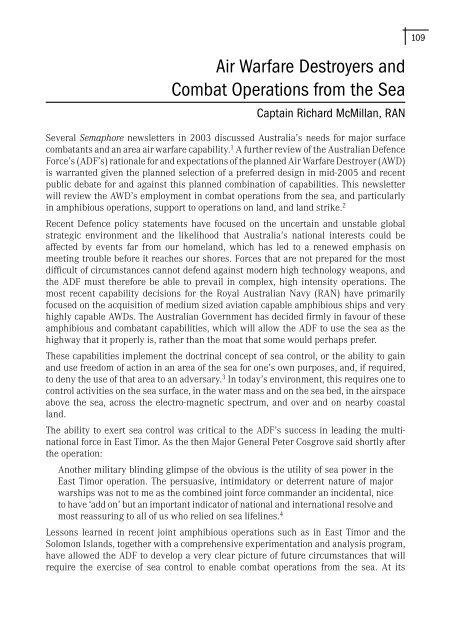Australian Maritime Issues 2005 - Royal Australian Navy
Australian Maritime Issues 2005 - Royal Australian Navy
Australian Maritime Issues 2005 - Royal Australian Navy
You also want an ePaper? Increase the reach of your titles
YUMPU automatically turns print PDFs into web optimized ePapers that Google loves.
109<br />
Air Warfare Destroyers and<br />
Combat Operations from the Sea<br />
Captain Richard McMillan, RAN<br />
Several Semaphore newsletters in 2003 discussed Australia’s needs for major surface<br />
combatants and an area air warfare capability. 1 A further review of the <strong>Australian</strong> Defence<br />
Force’s (ADF’s) rationale for and expectations of the planned Air Warfare Destroyer (AWD)<br />
is warranted given the planned selection of a preferred design in mid-<strong>2005</strong> and recent<br />
public debate for and against this planned combination of capabilities. This newsletter<br />
will review the AWD’s employment in combat operations from the sea, and particularly<br />
in amphibious operations, support to operations on land, and land strike. 2<br />
Recent Defence policy statements have focused on the uncertain and unstable global<br />
strategic environment and the likelihood that Australia’s national interests could be<br />
affected by events far from our homeland, which has led to a renewed emphasis on<br />
meeting trouble before it reaches our shores. Forces that are not prepared for the most<br />
difficult of circumstances cannot defend against modern high technology weapons, and<br />
the ADF must therefore be able to prevail in complex, high intensity operations. The<br />
most recent capability decisions for the <strong>Royal</strong> <strong>Australian</strong> <strong>Navy</strong> (RAN) have primarily<br />
focused on the acquisition of medium sized aviation capable amphibious ships and very<br />
highly capable AWDs. The <strong>Australian</strong> Government has decided firmly in favour of these<br />
amphibious and combatant capabilities, which will allow the ADF to use the sea as the<br />
highway that it properly is, rather than the moat that some would perhaps prefer.<br />
These capabilities implement the doctrinal concept of sea control, or the ability to gain<br />
and use freedom of action in an area of the sea for one’s own purposes, and, if required,<br />
to deny the use of that area to an adversary. 3 In today’s environment, this requires one to<br />
control activities on the sea surface, in the water mass and on the sea bed, in the airspace<br />
above the sea, across the electro-magnetic spectrum, and over and on nearby coastal<br />
land.<br />
The ability to exert sea control was critical to the ADF’s success in leading the multinational<br />
force in East Timor. As the then Major General Peter Cosgrove said shortly after<br />
the operation:<br />
Another military blinding glimpse of the obvious is the utility of sea power in the<br />
East Timor operation. The persuasive, intimidatory or deterrent nature of major<br />
warships was not to me as the combined joint force commander an incidental, nice<br />
to have ‘add on’ but an important indicator of national and international resolve and<br />
most reassuring to all of us who relied on sea lifelines. 4<br />
Lessons learned in recent joint amphibious operations such as in East Timor and the<br />
Solomon Islands, together with a comprehensive experimentation and analysis program,<br />
have allowed the ADF to develop a very clear picture of future circumstances that will<br />
require the exercise of sea control to enable combat operations from the sea. At its

















